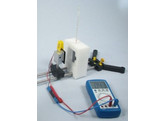Principle
This experiment explains the principle of the greenhouse effect. At a surface temperature of about 5600°C, the sun mainly irradiates heat radiation in an area of 500 nm in the direction of the Earth direction. The terrestrial atmosphere allows the radiation of this wavelength pass almost completely to the earth's surface and heats it up on average at about 30°C. The Earth's surface reflects back into the atmosphere mainly infrared radiation of the wavelength 10,000 nm (Wien's displacement law). Nevertheless, radiation of this wavelength is absorbed to a large part by the greenhouse gases (like CO2). The greenhouse gases, on the other hand, reflect heat radiation in the direction of earth's surface which heats it up additionally. This effect is called greenhouse effect. The name is to be led back on the fact that one finds the same principle also in a greenhouse, the "Earth's atmosphere" of the greenhouse is represented by the glass window.
In the experiment, the global warming of the Earth is shown via a black beaker with hot water. The greenhouse gases are substituted by a thin plastic disc.
The temperature of the water is controlled using a thermometer. The heat radiation delivered by the black beaker is measured by means of a thermo generator, (once with and once without the plastic disc) during the path of rays. The greenhouse effect can be observed in this process.
Benefits
Experiment is part of a complete solution set with a total of 17 experiments for Renewable Energy Basics and Heat energy
Versatile solar collector
Stable setup by using the optical bench
Tasks
How can one demonstrate the greenhouse effect?
What you can learn about
Greenhouse effect
Thermogenerator
This experiment explains the principle of the greenhouse effect. At a surface temperature of about 5600°C, the sun mainly irradiates heat radiation in an area of 500 nm in the direction of the Earth direction. The terrestrial atmosphere allows the radiation of this wavelength pass almost completely to the earth's surface and heats it up on average at about 30°C. The Earth's surface reflects back into the atmosphere mainly infrared radiation of the wavelength 10,000 nm (Wien's displacement law). Nevertheless, radiation of this wavelength is absorbed to a large part by the greenhouse gases (like CO2). The greenhouse gases, on the other hand, reflect heat radiation in the direction of earth's surface which heats it up additionally. This effect is called greenhouse effect. The name is to be led back on the fact that one finds the same principle also in a greenhouse, the "Earth's atmosphere" of the greenhouse is represented by the glass window.
In the experiment, the global warming of the Earth is shown via a black beaker with hot water. The greenhouse gases are substituted by a thin plastic disc.
The temperature of the water is controlled using a thermometer. The heat radiation delivered by the black beaker is measured by means of a thermo generator, (once with and once without the plastic disc) during the path of rays. The greenhouse effect can be observed in this process.
Benefits
Experiment is part of a complete solution set with a total of 17 experiments for Renewable Energy Basics and Heat energy
Versatile solar collector
Stable setup by using the optical bench
Tasks
How can one demonstrate the greenhouse effect?
What you can learn about
Greenhouse effect
Thermogenerator
Caractéristiques
- PP9513700
- P9513700

